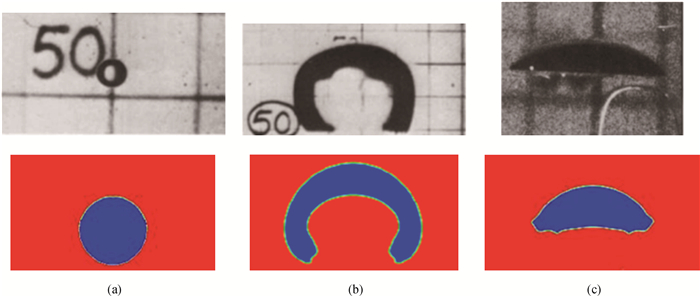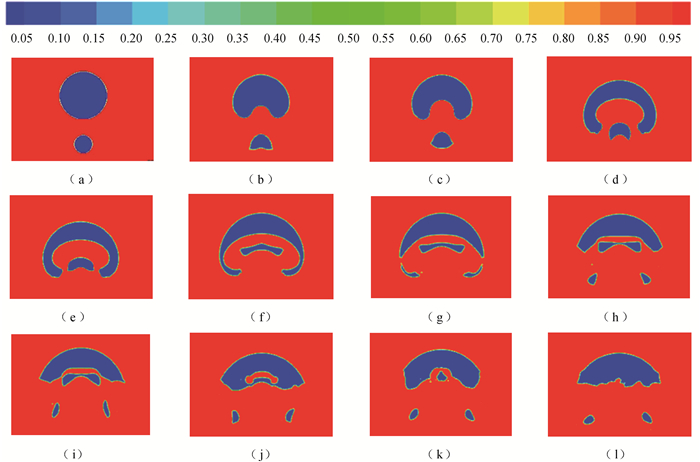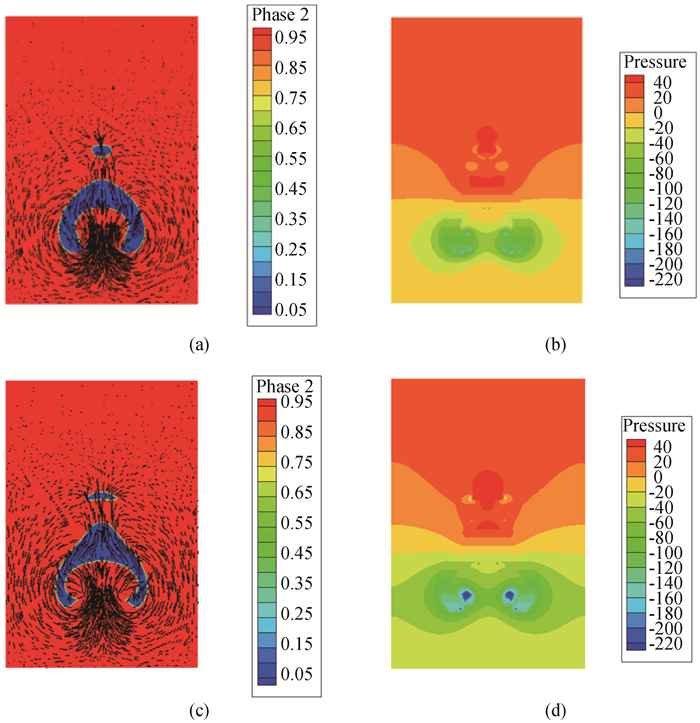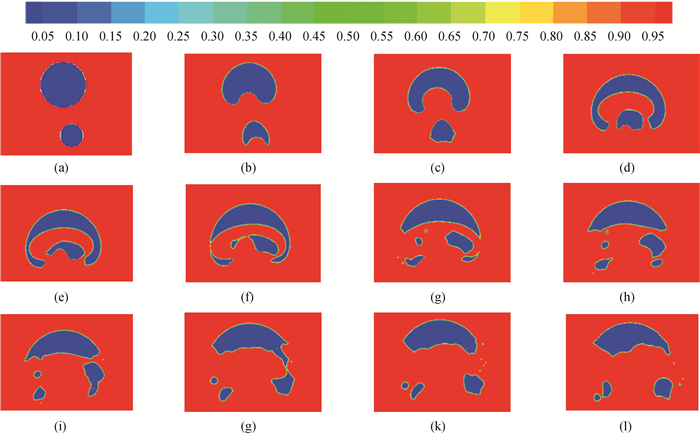Chinese Journal of Computational Physics ›› 2022, Vol. 39 ›› Issue (1): 41-52.DOI: 10.19596/j.cnki.1001-246x.8363
• Research Reports • Previous Articles Next Articles
Tengfei ZHAO( ), Hua ZHANG*(
), Hua ZHANG*( )
)
Received:2021-03-23
Online:2022-01-25
Published:2022-09-03
Contact:
Hua ZHANG
Tengfei ZHAO, Hua ZHANG. Analysis of Deformation and Breakage During Bubble Collision[J]. Chinese Journal of Computational Physics, 2022, 39(1): 41-52.
Add to citation manager EndNote|Ris|BibTeX
URL: http://www.cjcp.org.cn/EN/10.19596/j.cnki.1001-246x.8363

Fig.4 Contrast of single bubble ascending motion in still liquid at different moments(The upper row are images of experiment; The lower row are images of simulation.) (a) t=0.01 s; (b) t=0.1 s; (c) t=0.22 s
| 算例序号 | 先导气泡直径/mm | 尾随气泡直径/mm | 直径比 | 相对距离ξz |
| 1 | 2 | 8 | 0.25 | 0.75 |
| 2 | 4 | 8 | 0.5 | 0.75 |
| 3 | 6 | 8 | 0.75 | 0.75 |
| 4 | 8 | 8 | 1 | 0.75 |
| 5 | 8 | 6.4 | 1.25 | 0.75 |
| 6 | 8 | 5.3 | 1.5 | 0.75 |
| 7 | 8 | 4.57 | 1.75 | 0.75 |
| 8 | 8 | 4 | 2 | 0.75 |
| 9 | 8 | 3 | 2.67 | 0.75 |
| 10 | 8 | 3 | 2 | 0.25, 0.5, 0.75, 1 |
Table 1 Positive center collision calculation examples
| 算例序号 | 先导气泡直径/mm | 尾随气泡直径/mm | 直径比 | 相对距离ξz |
| 1 | 2 | 8 | 0.25 | 0.75 |
| 2 | 4 | 8 | 0.5 | 0.75 |
| 3 | 6 | 8 | 0.75 | 0.75 |
| 4 | 8 | 8 | 1 | 0.75 |
| 5 | 8 | 6.4 | 1.25 | 0.75 |
| 6 | 8 | 5.3 | 1.5 | 0.75 |
| 7 | 8 | 4.57 | 1.75 | 0.75 |
| 8 | 8 | 4 | 2 | 0.75 |
| 9 | 8 | 3 | 2.67 | 0.75 |
| 10 | 8 | 3 | 2 | 0.25, 0.5, 0.75, 1 |

Fig.5 Shape evolution in rising process of positive center collision of two bubbles (a) t=0 s; (b) t=0.04 s; (c) t=0.05 s; (d) t=0.08 s; (e) t=0.09 s; (f) t=0.11 s; (g) t=0.12 s; (h) t=0.14s; (i) t=0.15 s; (j) t=0.16 s; (k) t=0.17 s; (l) t=0.19 s

Fig.6 Bubble motion in positive center collision at 0.11 second (a) gas phase and velocity vectors; (b) pressure and velocity vectors; (c) Liutex vector and velocity vectors

Fig.11 Velocity vectors and pressure cloud maps during bubble rising (a) velocity vectors at 0.09 s; (b) pressures at 0.09 s; (c) velocity vectos at 0.11 s; (d) pressures at 0.11 s

Fig.13 Shape evolution in rising process of eccentric collision of two bubbles (a) t=0 s; (b) t=0.04 s; (c) t=0.06 s; (d) t=0.09 s; (e) t=0.1 s; (f) t=0.11 s; (g) t=0.12 s; (h) t=0.13 s; (i) t=0.14 s; (g) t=0.16 s; (k) t=0.17 s; (l) t=0.19 s

Fig.14 Bubble motion in eccentric collision at 0.1 second (a) gasous phase and velocity vectors; (b) pressure and velocity vectors; (c) Liutex vectors and velocity vectors
| 1 |
DOI |
| 2 |
|
| 3 |
DOI |
| 4 |
DOI |
| 5 |
|
| 6 |
|
| 7 |
|
| 8 |
|
| 9 |
张阿漫, 王诗平, 白兆宏, 等. 不同环境下气泡脉动特性实验研究[J]. 力学学报, 2011, 43 (1): 71- 83.
|
| 10 |
张阿漫, 姚熊亮, 李佳. 气泡群的动态物理特性研究[J]. 物理学报, 2008, 57 (3): 1672- 1682.
|
| 11 |
|
| 12 |
|
| 13 |
|
| 14 |
戚定满, 鲁传敬, 何友声. 两空泡运动特性研究[J]. 力学季刊, 2000, 21 (1): 16- 20.
|
| 15 |
|
| 16 |
DOI |
| 17 |
闻昭权. 气泡聚并机理的实验及模型研究[D]. 湘潭: 湘潭大学, 2019.
|
| 18 |
严鹏. 鼓泡塔内气液流动行为的CFD-PBM耦合模型数值模拟[D]. 北京: 北京石油化工学院, 2019.
|
| 19 |
|
| 20 |
李帅, 孙龙泉, 张阿漫. 水中上浮气泡动态特性研究[J]. 物理学报, 2014, 63 (18): 291- 303.
|
| 21 |
孙姣, 姜楠, 陈文义, 等. 静止水中单个近壁大气泡运动特性的实验研究[J]. 实验力学, 2019, 34 (6): 973- 980.
|
| 22 |
李文强, 焦守华, 唐珂, 等. 静水中单气泡运动特性实验研究[J]. 原子能科学技术, 2020, 54 (9): 1652- 1659.
|
| 23 |
DOI |
| 24 |
DOI |
| 25 |
DOI |
| 26 |
|
| 27 |
DOI |
| 28 |
|
| 29 |
DOI |
| 30 |
DOI |
| 31 |
DOI |
| 32 |
|
| 33 |
黄程蓉, 陈小鹏, 周丹, 等. 黏性溶液中单个气泡的运动形变[J]. 高校化学工程学报, 2018, 32 (5): 1012- 1028.
|
| 34 |
|
| 35 |
蒋炎坤, 褚开星. 基于VOF方法发动机水下排气气泡特性研究[J]. 华中科技大学学报(自然科学版), 2015, 43 (10): 10- 14.
|
| [1] | Li LIU, Shengli NIU, Jinhui ZHU, Yinghong ZUO, Honggang XIE, Peng SHANG. Numerical Simulation of Debris Motion from a Near-space Nuclear Detonation [J]. Chinese Journal of Computational Physics, 2022, 39(5): 521-528. |
| [2] | Liubin ZHANG, Yanguang SHAN, Zhicheng RONG. Single Bubble Dynamics in Pool Boiling Under Uniform Electric Field: LBM Simulation [J]. Chinese Journal of Computational Physics, 2022, 39(5): 537-548. |
| [3] | Liyuan WU, Suying ZHANG. Ground State of Bose-Einstein Condensates in a Spin-dependent Optical Lattice [J]. Chinese Journal of Computational Physics, 2022, 39(5): 617-623. |
| [4] | Xu-lin DU, Lin-song CHENG, Lang-yu NIU, Yu-ming CHEN, Ren-yi CAO, Yong-hong XIE. Numerical Simulation of 3D Discrete Fracture Networks Considering Dynamic Closure of Hydraulic Fractures and Natural Fractures [J]. Chinese Journal of Computational Physics, 2022, 39(4): 453-464. |
| [5] | Furong GUAN, Chengqian LI, Minyi DENG. Spiral Wave Dynamics of Excited Medium: Effect of Relative Refractory [J]. Chinese Journal of Computational Physics, 2021, 38(6): 749-756. |
| [6] | Junjie WANG, Jisheng KOU, Jianchao CAI, Yixin PAN, Zhen ZHONG. Tolman Length-based Modified Lucas-Washburn Capillary-driven Model and Numerical Simulation [J]. Chinese Journal of Computational Physics, 2021, 38(5): 521-533. |
| [7] | Zhankang YANG, Yi NIU. Influence of Temperature, Enclosure and Ventilation on Radon Concentration Distribution in a Blind Roadway [J]. Chinese Journal of Computational Physics, 2021, 38(4): 456-464. |
| [8] | Qin LOU, Sheng TANG, Haoyuan WANG. Numerical Simulation of Bubble Dynamics in Porous Media with a Lattice Boltzmann Large Density Ratio Model [J]. Chinese Journal of Computational Physics, 2021, 38(3): 289-300. |
| [9] | HU Shaoliang, XU Xiaowen, ZHENG Yuteng, ZHAO Zhenguo, WANG Weijie, XU Ran, AN Hengbin, MO Zeyao. Algorithms in Linear Solver for Large-scale Time-harmonic Maxwell's Equations in SiP Applications: State-of-the-art and Challenges [J]. Chinese Journal of Computational Physics, 2021, 38(2): 131-145. |
| [10] | CHEN Hao, CAI Ruming. Shape Optimization of Stratosphere Airship with Propeller [J]. CHINESE JOURNAL OF COMPUTATIONAL PHYSICS, 2020, 37(5): 562-570. |
| [11] | HU Yu, SUN Tao. Three-dimensional Numerical Simulation of Dynamics Characteristics of Two Rising Bubbles with Lattice Boltzmann Method [J]. CHINESE JOURNAL OF COMPUTATIONAL PHYSICS, 2020, 37(3): 277-283. |
| [12] | WANG Zimo, LI Ling. Lattice Boltzmann Simulation of Fast Phase Change in Ultrashort Laser Drilling [J]. CHINESE JOURNAL OF COMPUTATIONAL PHYSICS, 2020, 37(3): 299-306. |
| [13] | SUN Tao, LIU Zhibin, FAN Wei, QIN Haijie. Three-dimensional Numerical Simulation of Vapor Bubble Rising in Superheated Liquid by Lattice Boltzmann Method [J]. CHINESE JOURNAL OF COMPUTATIONAL PHYSICS, 2019, 36(6): 659-664. |
| [14] | WANG Zhi, ZOU Gaoyu, GONG Jing, BAI Jianfeng, ZHAI Bowen. A Pressure-based Algorithm for Numerical Simulation of One-dimensional Two-phase Flow [J]. CHINESE JOURNAL OF COMPUTATIONAL PHYSICS, 2019, 36(4): 413-420. |
| [15] | ZHANG Longhui, YOU Changfu. A Fictitious Domain Method Based on Finite Volume Scheme for Particulate Flows [J]. CHINESE JOURNAL OF COMPUTATIONAL PHYSICS, 2019, 36(3): 291-297. |
| Viewed | ||||||
|
Full text |
|
|||||
|
Abstract |
|
|||||
Copyright © Chinese Journal of Computational Physics
E-mail: jswl@iapcm.ac.cn
Supported by Beijing Magtech Co., Ltd.
